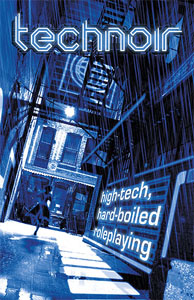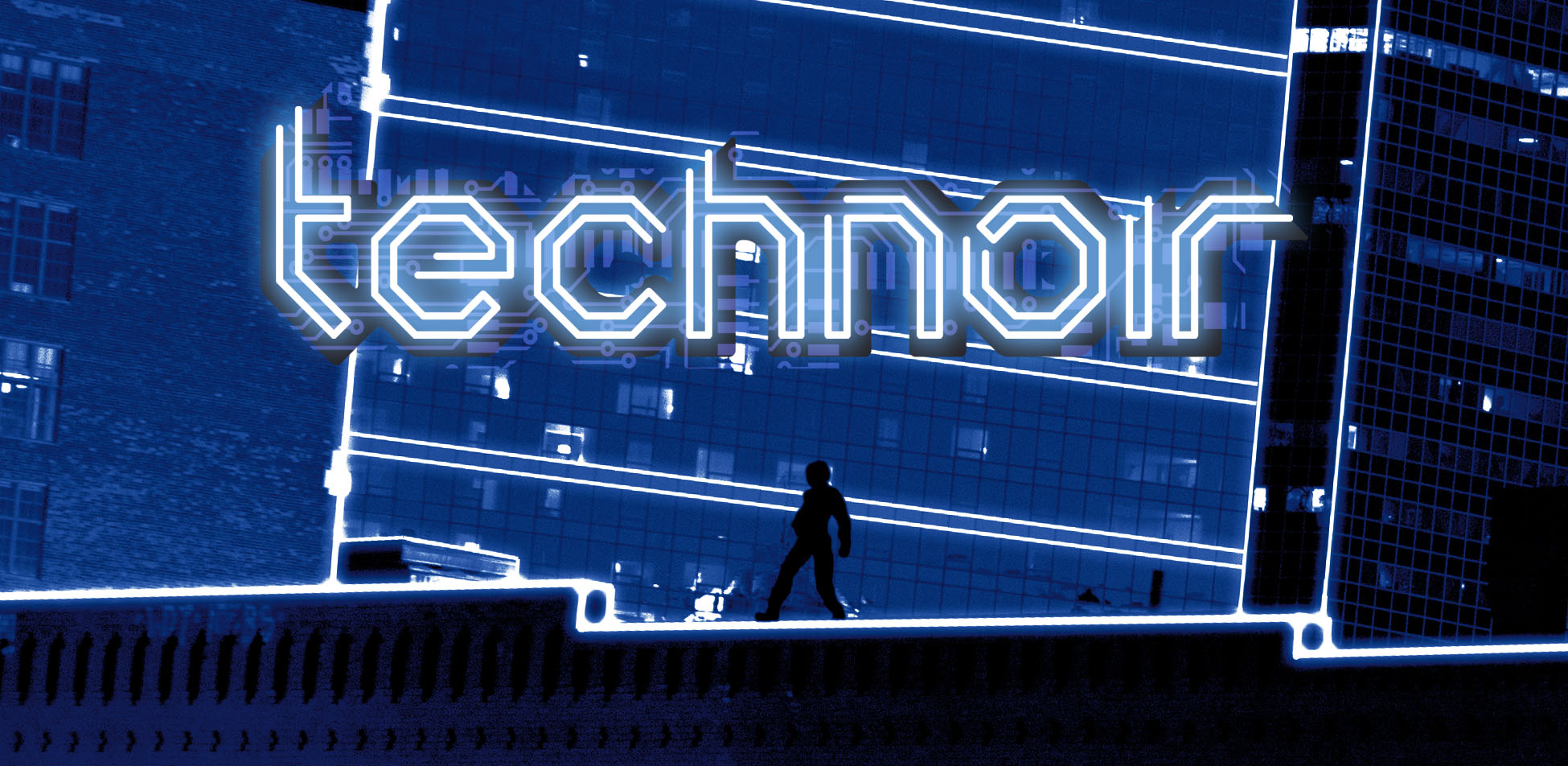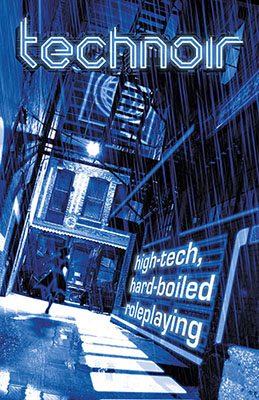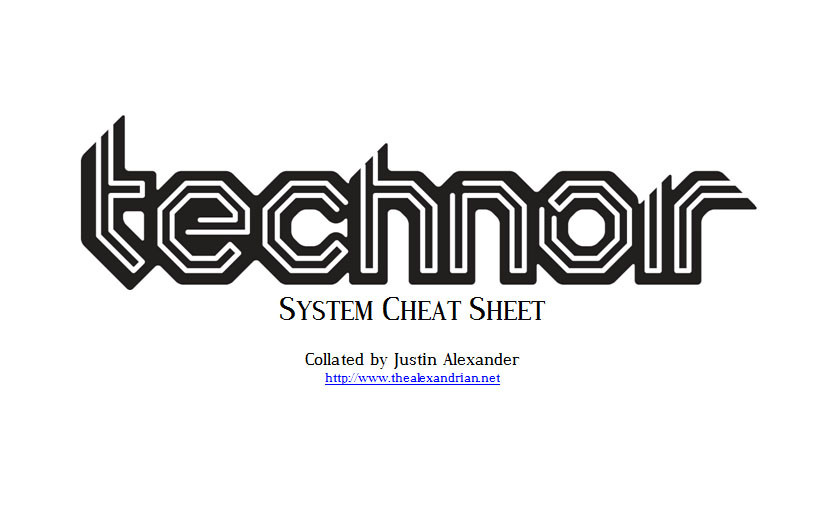Last week, in discussing how System Matters, I posited the hypothetical situation of an RPG which didn’t include a combat system. I did so because the entire concept is inherently radical: Including a D&D-derived combat system (even if it’s several generations distant from its progenitor) is such an essentially universal element of RPG design that the idea of a game which doesn’t do that is perceived as bizarre. I’ve actually seen people get angry at the suggestion, so ingrained has the expectation become.
So let’s talk about an RPG that actually does this: Technoir.
HOW TECHNOIR WORKS
We need to start by explaining how Technoir works:
First, characters are given numerical ratings in nine Verbs: Coax, Detect, Fight, Hack, Move, Operate, Prowl, Shoot, and Treat. These are basically the equivalent of ability scores seen in most roleplaying games.
 The core mechanic of Technoir is to use a Verb to push an Adjective onto a target. The Adjective is literally any adjective: A word describing a quality possessed by a noun (i.e., the person or thing that you targeted). By pushing an Adjective onto a target, you are changing the description of that thing. In doing so, of course, you are fundamentally affecting the fictional reality of that thing: A computer system which has been hacked or bot-slaved is fundamentally different from that has been secured.
The core mechanic of Technoir is to use a Verb to push an Adjective onto a target. The Adjective is literally any adjective: A word describing a quality possessed by a noun (i.e., the person or thing that you targeted). By pushing an Adjective onto a target, you are changing the description of that thing. In doing so, of course, you are fundamentally affecting the fictional reality of that thing: A computer system which has been hacked or bot-slaved is fundamentally different from that has been secured.
The mechanics of the game elaborate on this central conceit by (a) varying the severity of the Adjective you can apply (from fleeting to sticky to locked), (b) giving you mechanical structures for using these Adjective (so that they’re not just nebulous descriptions of fictional state, but also mechanically meaningful constructs), and (c) providing mechanical methods for removing negative Adjectives.
The cool thing about these mechanics is that they’re not dependent on the Adjectives you’re pushing: The mechanical structures work whether you’re pushing bullet-riddled or sympathetic or terrified.
STAKES IN TECHNOIR
In most RPGs, the combat system defaults to “I want him dead” as the stakes for the scene. In fact, this is often the only time traditional RPGs mechanically declare whether or not the stakes of a scene are achieved. (Most RPGs provide lots of mechanics for determining whether a specific method chosen by a character has been successful, but ultimately leave the question of whether or not that allows the character to achieve their actual goal to the GM fiat. See The Art of Rulings for a lengthier discussion of this.)
Technoir goes in almost exactly the opposite direction: You can’t push “unconscious” or “dead” or anything else that could remove the target’s agency in one hit unless your target is a Henchman (i.e., a mook). You can trivially set virtually anything else as the stakes for a roll, but not death.
This is a mechanical implementation of one of the pillars that Technoir identifies in the hard-boiled stories it’s seeking to emulate:
COME AT THEM SIDEWAYS
The conspiracy is bigger than her. The forces she’s dealing with could crush her like an insect. She can’t just kill all her enemies, she’ll have to outwit them. As such, this game doesn’t have a combat system designed for defeating opponents. It has a social manipulation system that gives the player the means to influence characters and nudge the narrative direction in which violent methods may be employed.
One of the semi-invisible consequences of combat systems and death being the only place where traditional RPGs mechanically declare a scene’s outcome is that a lot of GMs and players have become heavily conditioned over the years to think of death as the default ending for any conflict. And this is really weird when you think about it, because it’s not the way it generally works in other storytelling mediums (and it’s definitely not the way it works in real life).
Technoir breaks that conditioning. This means that the GM and players alike need to think about what they really want and how they can achieve that. The concept of vectors is really important in Technoir: If you want to achieve X by doing Y, then there needs to be a clear path by which Y can achieve X. You need to line up your shot. The fact that vectors aren’t always a straight line is, of course, the whole point. Sometimes the PCs have to push one adjective onto an NPC before they can push the one that they want (you need to get them trusting you before you can seduce them into being vulnerable). Or you’ll need to make it stick before you can lock it down.
The same is true for NPCs: If you’re the GM, make sure you know what they actually want out of the scene. Once they’ve got it, they aren’t going to stick around. Have them push the escaped adjective onto themselves, spend the Push dice they need to lock it against the players, and skedaddle.
DEATH IN TECHNOIR
All of this is not to say that character death is taken completely off the table in Technoir. What good noir story doesn’t feature death, after all? What if what an PC wants is to kill a PC? For example, let’s say the GM wants to frame a scene where a sniper takes a shot at a PC because they’ve been asking the wrong sort of questions.
The assassin’s bullet is going to push mortally wounded as an adjective onto the PC and the GM is going to lock that fucker in place by spending a couple of Push dice. And the important part is that once they’ve taken that shot — once they’ve pushed that adjective — the scene probably ends.
At this point the rules for “Lethal Consequences” are going to kick in: “At the end of any scene in which one or more adjectives were asserted that describe physical harm against a character, there is a chance that adjective might lead to the character’s death.” The specific mechanics for working that out aren’t particularly important for this discussion (but you can find them on page 138 of the rulebook). The point is that the PC has to check to see if he’s dying from this adjective or not. Even if he’s not dying from the wound, of course, he’s still going to be permanently debilitated by his injury until somebody pays to chrome him up.
And when the assassin finds out his target somehow survived the shot, he’s going to be coming back to try again. What are the PCs going to do about that?
That final bit is the really key element to grokking Technoir: The question of, “Do you live or die?” is not intrinsically interesting. You might die, but the game is far more interested in making you own your adjectives and then asking, “And what do you do about that? How do you fix it? How do you live with it?” Mortal injuries from sniper rifles aren’t inherently more significant in that equation that having your heart metaphorically ripped out.
As far as NPC death is concerned, I’ve already mentioned that Henchmen can be killed in a single shot (by spending Push dice to make dead lock onto them). The rulebook is a little less clear about what it takes to knock out Heavies and Connections (the other categories of NPCs), but what it boils down to is vector: If the PCs can put themselves in a position where they can justify getting the bullet to stick, the GM should let it stick. (That might mean beating them bloody. It might mean compromising their security. It might mean breaking their leg and making them helpless before you cap a bullet into their skull. It’ll depend on circumstances.) Note, too, that the “Lethal Consequences” rules don’t specify player characters; in fact, it says the opposite. The GM can (and should) use those rules for NPCs, too: You shot the Bride in the head and left her dead, but she woke up.
What are you going to do about that?
















